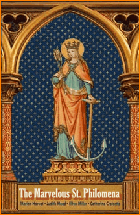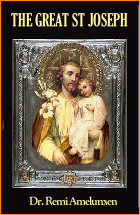Symbolism
 |
 |
 |
 |
 |
 |
 |
The Gourd: A Sign of Christ’s Resurrection
& Man’s Penance
The lily, the bursting pomegranate, the palm and, of course, the egg are all well-known symbols of the Resurrection. Not so the lowly gourd. Yet, I believe readers will find how it earned its place in both Lenten and Resurrection symbology quite interesting.
The apple alongside the gourd
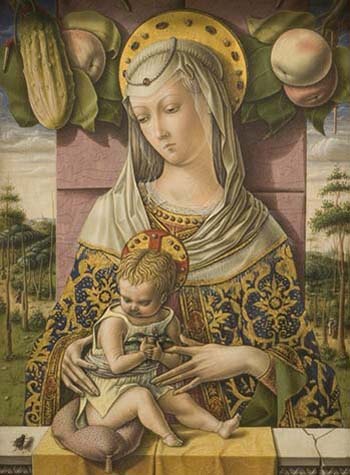 In many medieval and Renaissance paintings, we find the apple representing sin and the Fall of Man along with its antidote, the gourd, representing the Resurrection of Christ, who redeemed fallen man from the death of sin. It is the triumph of Salvation over Damnation – easily recognized and understood by Catholic men of the past through symbols.
In many medieval and Renaissance paintings, we find the apple representing sin and the Fall of Man along with its antidote, the gourd, representing the Resurrection of Christ, who redeemed fallen man from the death of sin. It is the triumph of Salvation over Damnation – easily recognized and understood by Catholic men of the past through symbols.
Carlo Crivelli's Madonna with the Child shows the apple (top right) as the symbol of Sin or Death and the gourd (top left) as the Resurrection. In fact, Crivelli used the apple-gourd motif so often in his paintings that it has been called his “signature motif.” In his 1486 painting title The Annunciation with St. Emidius, we find the gourd and the apple at the base, again representing the Fall and Redemption that will be won for mankind through the fiat of Our Lady.
Modern man easily understand why the apple represents the Fall of man. But, why would the gourd be a sign of man's redemption?
The gourd associated with Jonah, a prefigure of Christ
By association the gourd was linked to Jonah, an Old Testament prefigure of Christ. Here is the well-known story:
Jonah was told by God to go to Niniveh (in present day Iraq) to prophesy the destruction of the city and all its inhabitants for their idolatry and evil ways. Trying to escape the divine mission, Jonah took a ship sailing to Tarshish. During the journey a storm arose, and Jonah was thrown by the crew into the ocean where he was swallowed by a whale. He remained for three days and three nights in its belly, and then, the great fish ejected the prophet out onto the shoreline.
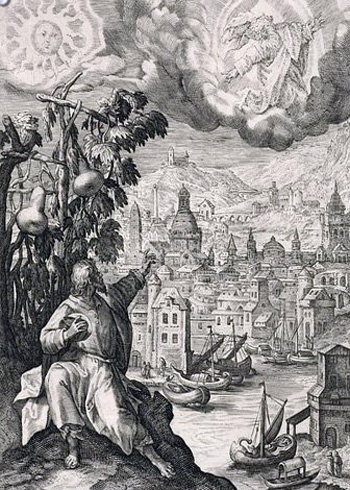 In Mt 12:40, Christ says, “For just as Jonah was three days and three nights in the belly of the great fish, so will the Son of Man be three days and three nights in the heart of the earth.” Thus Jonah became a symbol for Catholics of the Resurrection of Christ.
In Mt 12:40, Christ says, “For just as Jonah was three days and three nights in the belly of the great fish, so will the Son of Man be three days and three nights in the heart of the earth.” Thus Jonah became a symbol for Catholics of the Resurrection of Christ.
Jonah was then ordered again by God to go to the great city of Niniveh and warn the populace that God would destroy their city in 40 days, a command he duly followed. The King and people, however, heeded his warning and atoned, making acts of sacrifice and prayer, and God spared the city.
Jonah, who had withdrawn from the city and was awaiting the punishment to fall, was displeased at God's mercy showed to Nineveh. Overheated and weakened under the hot desert sun, he found respite under a gourd plant that God made grow overnight to provide him with needed shade.
The next day a worm attacked the plant, causing it to wither and leaving Jonah distressed. Then God rebuked Jonah for being upset over the loss of the gourd that "came up in a day and was lost in a day," a trivial thing compared to the loss of the lives of 120,000 Ninevans.
Instead of sorrowing over God's mercy, Jonah should have rejoiced that they were saved because they heeded his admonitions. For Jonah went to Nineveh for its salvation as Christ ascended to Heaven to make the New Jerusalem. The gourd thus represents the new life to be enjoyed by the people of Nineveh after repentance and deliverance from destruction. The worm is Jonah's bitterness over the salvation of his enemies.
From the early centuries we find in many Catacombs paintings of the story of Jonah being cast up to shore by the whale and then reposing under a bush covered with long-shaped gourds on a hill outside Nineveh. Also, Jonah – who was reproved by means of a gourd vine – is sometimes identified among the prophets by a gourd.
Penance on our earthly pilgrimage
The Church placed the lesson from Jonas the Prophet (Chap III) in the Epistle of Monday in Passion week to remind Catholics of the transient nature of earthly pleasures and the importance of perseverance in our penances and mortifications.
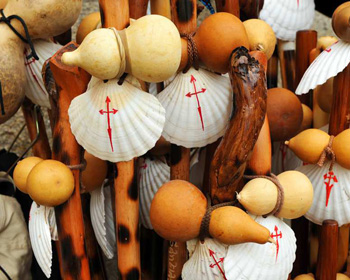 The flowing gourd bush with its many plants grew in a night at God's command to comfort Jonah, but also it withered in a day. This reminds us while we must have confidence in God's goodness, we also cannot forget that the goods and pleasures of this life are short-lived and we must live our lives as pilgrims in this earthly life with our attention turned toward reaching Heaven, our true home.
The flowing gourd bush with its many plants grew in a night at God's command to comfort Jonah, but also it withered in a day. This reminds us while we must have confidence in God's goodness, we also cannot forget that the goods and pleasures of this life are short-lived and we must live our lives as pilgrims in this earthly life with our attention turned toward reaching Heaven, our true home.
Thus it became a custom for a pilgrim to the holy places to hang on his staff a hallowed gourd, which was used as a flask to carry water. The hard-shelled but perishable fruit – which "comes up in a night and perishes in a night" at the Lord's command – signified the transience of earthly life and its pleasures.
In time, the rod and calabash gourd bottle became identifying symbols of the pilgrim on the Camino de Santiago (Road of St. James). It also became common to represent the Archangel Raphael who accompanied Tobias on his journey with the pilgrim's staff and rod with the gourd flask.
The spat of St. Jerome & St. Augustine
To close, I will deviate a bit to recount how our lowly gourd became the central point of contention between St. Jerome and St. Augustine.
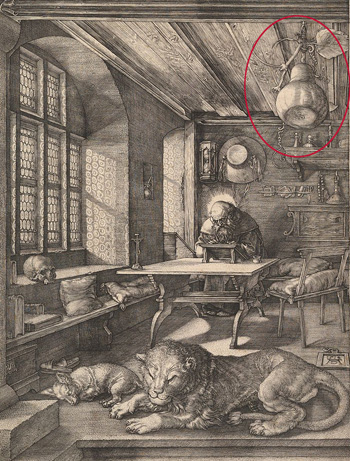 The decade-long fight started from St. Jerome's translation of the passage from the Book of Jonah (4-6): "And the Lord God prepared a gourd, and made it to come up over Jonah, that it might be a shadow over his head, to deliver him from his grief. So Jonah was exceeding glad of the gourd." St. Jerome translated the Hebrew word קִיקָיוֹן (kikayon) into Latin as hedera, a type of ivy, rejecting the older Latin reading of cucubita or gourd, as less precise.;
The decade-long fight started from St. Jerome's translation of the passage from the Book of Jonah (4-6): "And the Lord God prepared a gourd, and made it to come up over Jonah, that it might be a shadow over his head, to deliver him from his grief. So Jonah was exceeding glad of the gourd." St. Jerome translated the Hebrew word קִיקָיוֹן (kikayon) into Latin as hedera, a type of ivy, rejecting the older Latin reading of cucubita or gourd, as less precise.;
Now, Jerome was attacked fiercely for this alteration by many scholars. The controversy intensified after St. Augustine, who followed the Septuagist and Syriac readings, entered the debate in 403 with gusto. Indeed, it reached the point that Augustine stopped the reading of St. Jerome's Vulgate throughout his diocese, not hesitating to judge this translation of the word into ivy as a heresy. Jerome issued a lengthy commentary devoted to the verse defending his translation with his customary satirical vehemence.
In the end Augustine's view prevailed. The Renaissance humanist artist Albrecht Dürer memorialized Jerome's acquiescence in the philological controversy by etching a large dried gourd hanging from the rafters in his famous engraving St Jerome in His Study, a picture so filled with symbols it would merit an analysis on its own. A great admirer of St. Jerome, Durer was praising his humility in ceding way in that famous spat.
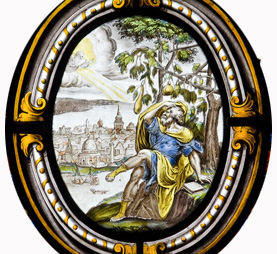

Posted April 13, 2020
The apple alongside the gourd

Madonna with the Child – The apple at the top right; the gourd at the top left – Sin and resurrection
Carlo Crivelli's Madonna with the Child shows the apple (top right) as the symbol of Sin or Death and the gourd (top left) as the Resurrection. In fact, Crivelli used the apple-gourd motif so often in his paintings that it has been called his “signature motif.” In his 1486 painting title The Annunciation with St. Emidius, we find the gourd and the apple at the base, again representing the Fall and Redemption that will be won for mankind through the fiat of Our Lady.
Modern man easily understand why the apple represents the Fall of man. But, why would the gourd be a sign of man's redemption?
The gourd associated with Jonah, a prefigure of Christ
By association the gourd was linked to Jonah, an Old Testament prefigure of Christ. Here is the well-known story:
Jonah was told by God to go to Niniveh (in present day Iraq) to prophesy the destruction of the city and all its inhabitants for their idolatry and evil ways. Trying to escape the divine mission, Jonah took a ship sailing to Tarshish. During the journey a storm arose, and Jonah was thrown by the crew into the ocean where he was swallowed by a whale. He remained for three days and three nights in its belly, and then, the great fish ejected the prophet out onto the shoreline.

Jonah under the gourd tree
Jonah was then ordered again by God to go to the great city of Niniveh and warn the populace that God would destroy their city in 40 days, a command he duly followed. The King and people, however, heeded his warning and atoned, making acts of sacrifice and prayer, and God spared the city.
Jonah, who had withdrawn from the city and was awaiting the punishment to fall, was displeased at God's mercy showed to Nineveh. Overheated and weakened under the hot desert sun, he found respite under a gourd plant that God made grow overnight to provide him with needed shade.
The next day a worm attacked the plant, causing it to wither and leaving Jonah distressed. Then God rebuked Jonah for being upset over the loss of the gourd that "came up in a day and was lost in a day," a trivial thing compared to the loss of the lives of 120,000 Ninevans.
Instead of sorrowing over God's mercy, Jonah should have rejoiced that they were saved because they heeded his admonitions. For Jonah went to Nineveh for its salvation as Christ ascended to Heaven to make the New Jerusalem. The gourd thus represents the new life to be enjoyed by the people of Nineveh after repentance and deliverance from destruction. The worm is Jonah's bitterness over the salvation of his enemies.
From the early centuries we find in many Catacombs paintings of the story of Jonah being cast up to shore by the whale and then reposing under a bush covered with long-shaped gourds on a hill outside Nineveh. Also, Jonah – who was reproved by means of a gourd vine – is sometimes identified among the prophets by a gourd.
Penance on our earthly pilgrimage
The Church placed the lesson from Jonas the Prophet (Chap III) in the Epistle of Monday in Passion week to remind Catholics of the transient nature of earthly pleasures and the importance of perseverance in our penances and mortifications.

Staffs with their shells and gourd bottles for pilgrims on the Road to Santiago
Thus it became a custom for a pilgrim to the holy places to hang on his staff a hallowed gourd, which was used as a flask to carry water. The hard-shelled but perishable fruit – which "comes up in a night and perishes in a night" at the Lord's command – signified the transience of earthly life and its pleasures.
In time, the rod and calabash gourd bottle became identifying symbols of the pilgrim on the Camino de Santiago (Road of St. James). It also became common to represent the Archangel Raphael who accompanied Tobias on his journey with the pilgrim's staff and rod with the gourd flask.
The spat of St. Jerome & St. Augustine
To close, I will deviate a bit to recount how our lowly gourd became the central point of contention between St. Jerome and St. Augustine.

Dürer portrays the gourd in the right top of his famous engraving, St. Jerome in His Study
Now, Jerome was attacked fiercely for this alteration by many scholars. The controversy intensified after St. Augustine, who followed the Septuagist and Syriac readings, entered the debate in 403 with gusto. Indeed, it reached the point that Augustine stopped the reading of St. Jerome's Vulgate throughout his diocese, not hesitating to judge this translation of the word into ivy as a heresy. Jerome issued a lengthy commentary devoted to the verse defending his translation with his customary satirical vehemence.
In the end Augustine's view prevailed. The Renaissance humanist artist Albrecht Dürer memorialized Jerome's acquiescence in the philological controversy by etching a large dried gourd hanging from the rafters in his famous engraving St Jerome in His Study, a picture so filled with symbols it would merit an analysis on its own. A great admirer of St. Jerome, Durer was praising his humility in ceding way in that famous spat.


Posted April 13, 2020
______________________
______________________




